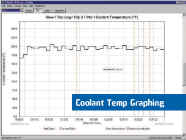DO-IT-YOURSELFERS
|
CarChip plugs into the OBDII connector in your car. But unlike the hand-held scan tools designed for use in the garage or during a limited test drive, CarChip remains in your car continuously, recording data from the car’s computer control sensors every few seconds, on every trip. In addition to monitoring speed, distance, acceleration, and deceleration, CarChipE/X will let you log any 4 out of 23 possible engine parameters, all of which can affect operation, emissions, and fuel economy. This can help you diagnose and fix problems, eliminating "guess-and-replace" repairs. If your car’s check engine light comes on, you can use the Car-Chip software to view the trouble code, its description, and the associated freeze-frame sensor readings. With CarChipE/X, you’ll also have the additional information you need to simplify diagnosis. For example, an oxygen sensor trouble code doesn’t necessarily mean that your oxygen sensor is bad; it could mean that an intake leak is allowing too much air into the combustion chamber, and the fuel/air mixture is too lean. With CarChipE/X, you’ll be able to review graphs of the oxygen sensor voltage over time and of the related engine parameters you’ve selected, helping you determine exactly where the problem lies.
|
• In 2001, the average cost for gasoline and oil was close to eight cents a mile for a mid-size car. At 15,000 miles per year, that’s an annual cost of $1200. • Old spark plugs can reduce fuel economy by 30%; a faulty oxygen sensor can cut it by as much as 40%. • Maintaining an older car in good running condition saves money compared to buying a new one. Including service and repair costs, trading in a vehicle every eight years instead of every four saves an average of $2500 a year do-it-yourselfers save even more.
|
 By
detecting malfunctions early and taking the guesswork out of diagnosing
problems, CarChip can help do-it-yourself mechanics keep
their cars running at peak performance.
By
detecting malfunctions early and taking the guesswork out of diagnosing
problems, CarChip can help do-it-yourself mechanics keep
their cars running at peak performance. Using
CarChipE/X, Henry discovered that coolant temperature in
his Ford Aspire was running low—about 183°F during his commute, instead
of the 195°F it should have been. Henry replaced the
engine’s thermostat (a part that is critical to the operation of today’s
vehicles), and then rechecked the data a few days later. New
graphs of the coolant temperature showed that the average temperature
was right where it should be. As a bonus, Henry also noticed
that his average fuel economy had gone up about 7%.
Using
CarChipE/X, Henry discovered that coolant temperature in
his Ford Aspire was running low—about 183°F during his commute, instead
of the 195°F it should have been. Henry replaced the
engine’s thermostat (a part that is critical to the operation of today’s
vehicles), and then rechecked the data a few days later. New
graphs of the coolant temperature showed that the average temperature
was right where it should be. As a bonus, Henry also noticed
that his average fuel economy had gone up about 7%.